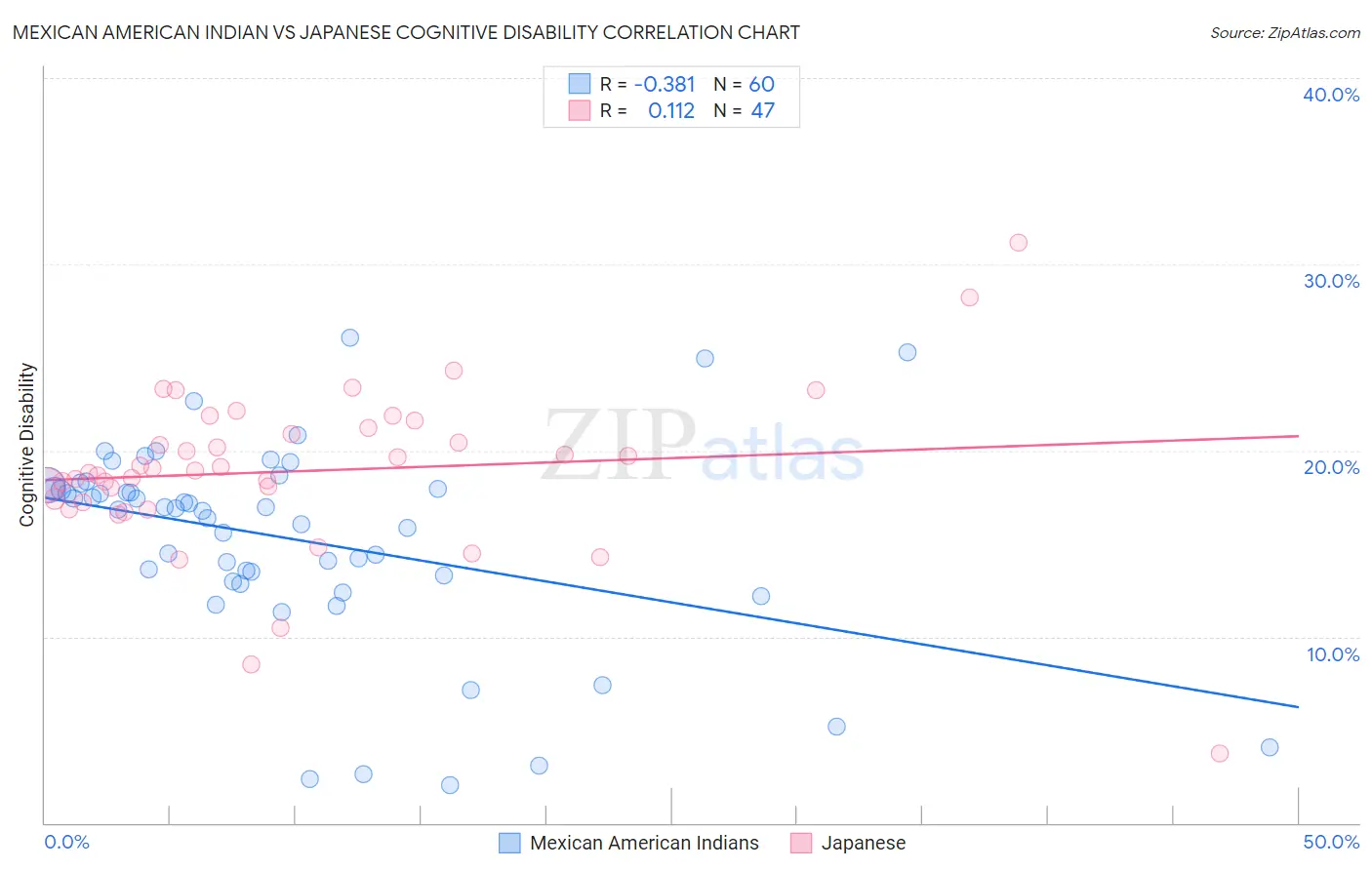Mexican American Indian vs Japanese Cognitive Disability
COMPARE
Mexican American Indian
Japanese
Cognitive Disability
Cognitive Disability Comparison
Mexican American Indians
Japanese
17.9%
COGNITIVE DISABILITY
0.6/ 100
METRIC RATING
257th/ 347
METRIC RANK
18.3%
COGNITIVE DISABILITY
0.0/ 100
METRIC RATING
298th/ 347
METRIC RANK
Mexican American Indian vs Japanese Cognitive Disability Correlation Chart
The statistical analysis conducted on geographies consisting of 317,571,331 people shows a mild negative correlation between the proportion of Mexican American Indians and percentage of population with cognitive disability in the United States with a correlation coefficient (R) of -0.381 and weighted average of 17.9%. Similarly, the statistical analysis conducted on geographies consisting of 249,155,070 people shows a poor positive correlation between the proportion of Japanese and percentage of population with cognitive disability in the United States with a correlation coefficient (R) of 0.112 and weighted average of 18.3%, a difference of 1.9%.

Cognitive Disability Correlation Summary
| Measurement | Mexican American Indian | Japanese |
| Minimum | 2.0% | 3.7% |
| Maximum | 26.0% | 31.2% |
| Range | 24.0% | 27.4% |
| Mean | 15.2% | 18.9% |
| Median | 16.9% | 18.9% |
| Interquartile 25% (IQ1) | 13.1% | 17.2% |
| Interquartile 75% (IQ3) | 18.0% | 21.2% |
| Interquartile Range (IQR) | 4.9% | 4.0% |
| Standard Deviation (Sample) | 5.4% | 4.5% |
| Standard Deviation (Population) | 5.4% | 4.4% |
Similar Demographics by Cognitive Disability
Demographics Similar to Mexican American Indians by Cognitive Disability
In terms of cognitive disability, the demographic groups most similar to Mexican American Indians are Immigrants from Armenia (17.9%, a difference of 0.010%), Bahamian (17.9%, a difference of 0.040%), Hopi (17.9%, a difference of 0.050%), Hispanic or Latino (17.9%, a difference of 0.050%), and Immigrants from the Azores (17.9%, a difference of 0.050%).
| Demographics | Rating | Rank | Cognitive Disability |
| Immigrants | Ethiopia | 0.7 /100 | #250 | Tragic 17.9% |
| Malaysians | 0.6 /100 | #251 | Tragic 17.9% |
| Immigrants | Grenada | 0.6 /100 | #252 | Tragic 17.9% |
| Hopi | 0.6 /100 | #253 | Tragic 17.9% |
| Hispanics or Latinos | 0.6 /100 | #254 | Tragic 17.9% |
| Immigrants | Azores | 0.6 /100 | #255 | Tragic 17.9% |
| Bahamians | 0.6 /100 | #256 | Tragic 17.9% |
| Mexican American Indians | 0.6 /100 | #257 | Tragic 17.9% |
| Immigrants | Armenia | 0.6 /100 | #258 | Tragic 17.9% |
| Ethiopians | 0.5 /100 | #259 | Tragic 17.9% |
| Immigrants | Belize | 0.5 /100 | #260 | Tragic 17.9% |
| Guamanians/Chamorros | 0.5 /100 | #261 | Tragic 17.9% |
| Sierra Leoneans | 0.4 /100 | #262 | Tragic 17.9% |
| Immigrants | Barbados | 0.4 /100 | #263 | Tragic 17.9% |
| Menominee | 0.4 /100 | #264 | Tragic 18.0% |
Demographics Similar to Japanese by Cognitive Disability
In terms of cognitive disability, the demographic groups most similar to Japanese are Blackfeet (18.3%, a difference of 0.0%), Ghanaian (18.3%, a difference of 0.030%), Creek (18.3%, a difference of 0.060%), Immigrants from Burma/Myanmar (18.2%, a difference of 0.14%), and German Russian (18.2%, a difference of 0.17%).
| Demographics | Rating | Rank | Cognitive Disability |
| Ottawa | 0.1 /100 | #291 | Tragic 18.2% |
| Iroquois | 0.1 /100 | #292 | Tragic 18.2% |
| Central American Indians | 0.1 /100 | #293 | Tragic 18.2% |
| British West Indians | 0.1 /100 | #294 | Tragic 18.2% |
| German Russians | 0.0 /100 | #295 | Tragic 18.2% |
| Immigrants | Burma/Myanmar | 0.0 /100 | #296 | Tragic 18.2% |
| Blackfeet | 0.0 /100 | #297 | Tragic 18.3% |
| Japanese | 0.0 /100 | #298 | Tragic 18.3% |
| Ghanaians | 0.0 /100 | #299 | Tragic 18.3% |
| Creek | 0.0 /100 | #300 | Tragic 18.3% |
| Immigrants | Ghana | 0.0 /100 | #301 | Tragic 18.3% |
| Barbadians | 0.0 /100 | #302 | Tragic 18.3% |
| Immigrants | Kenya | 0.0 /100 | #303 | Tragic 18.3% |
| Immigrants | Eritrea | 0.0 /100 | #304 | Tragic 18.3% |
| Colville | 0.0 /100 | #305 | Tragic 18.3% |